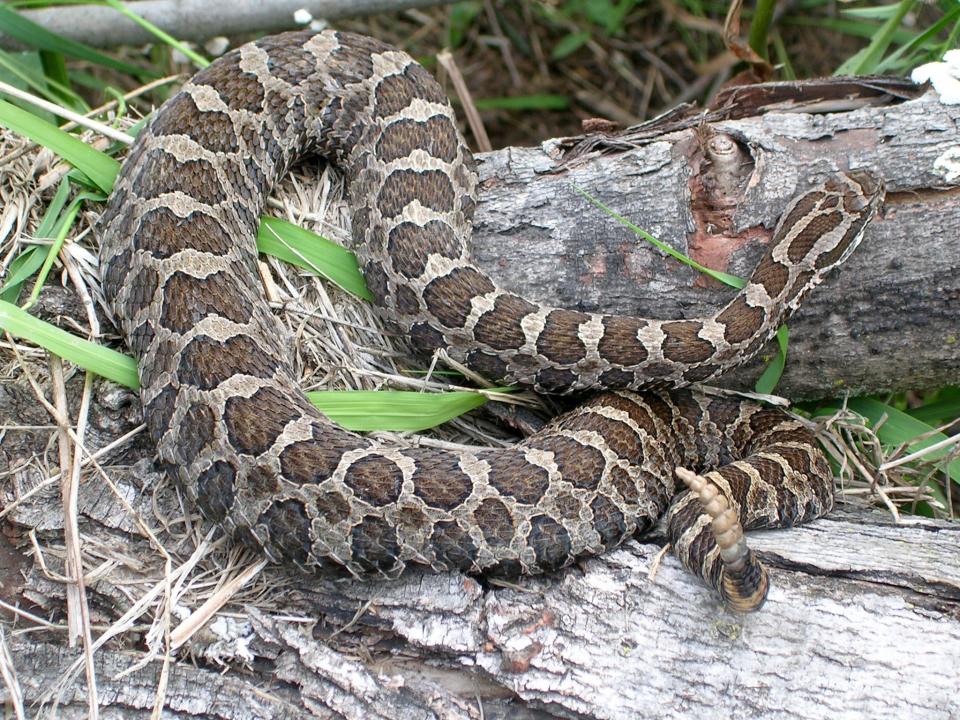What you should do if you get bitten by a snake
A minor league baseball team in Wisconsin is named after a snake — the Wisconsin Timber Rattlers — so there has to be plenty of those slithering creatures around us, right?
While snakes aren't as abundant in Wisconsin as they are in Texas or Arizona, don't be surprised if you encounter one when you're out hiking and camping this summer.
It just might not be the rare timber rattlesnake.
Here's what you should know about snakes in Wisconsin.
Are snakes common in Wisconsin?
There are 22 snake species in Wisconsin, according to the state's Department of Natural Resources. Thirteen of the species are labeled as "rare," meaning they are on the endangered, threatened or special concern lists. The rest are labeled as "common."
Texas has the most number of snake species at over 100. Arizona has more than five dozen snake species.
What is the most common snake in Wisconsin?
The common garter snake is most populous in Wisconsin, the DNR notes. It's in every county of the state and they are heavily populated in forest and woodlot edges and rely on open canopy wetlands during the winter.
You may see a group together, as well. These non-venomous snakes often "den" together in large numbers, the DNR says. The snakes, which vary in color pattern, have eight yellow stripes across the length of their body. They range in size from 17 inches to 26 inches.
Are there any poisonous snakes in Wisconsin and where could I find them?
Yes. Two species of rattlesnakes inhabit Wisconsin: the timber rattlesnake and the eastern massasauga. Rattlesnakes contain a poisonous venom.
Eastern massasauga is a state endangered species and federally threatened species. The timber rattlesnake is a protected wild animal and labeled as a special concern species.
Both species are shy and secretive animals, the DNR says. They use their coloration to avoid being seen.
The eastern massasauga, primarily located in central Wisconsin down to the southern part of the state, could be seen along medium to large rivers, and they primarily occupy open canopy wetlands, fresh wet meadows, shrub-carrs, and adjacent upland prairies, floodplain forests and old fields.
For the timber rattlesnake, adult males and non-gravid adult females can be found in forests and woodland edges in an agricultural setting. Gravid females and juveniles stay in open-canopy bluff prairies. The timber rattlesnake resides mostly in western Wisconsin.
Despite perception, Wisconsin rattlesnakes aren't aggressive and typically only strike if they are harassed or cornered, the DNR indicates.

Where are snakes found in Wisconsin?
Snakes are all over the state, including in large cities. For example, the butler's garter snake, which is a special concern species in Wisconsin, has habitats in southern Wisconsin, including in Milwaukee County. These snakes reside in wetland habitats or semi-open canopy upland habitats, such as prairies, old fields and weedy vacant lots.
Then there are the eastern hog-nosed snakes, which can be found in nearly every county. Habitats include bracken grassland, oak savanna and sand prairies.
Another example of a special concern snake species is the western wormsnake, which is only in southwest Grant County. These snakes prefer to stay in bluff prairies, and adjacent savannas and open woodland. They also spend most of their time under partially embedded rocks or underground.
The queensnake, which is listed as endangered in Wisconsin, prefers clear warm-water streams and small rivers and is found in multiple southern counties.
What should I do if I get bitten by a snake?
While there are mostly non-venomous snakes in Wisconsin, a bite from any snake can result in an infection or allergic reaction, according to Johns Hopkins Medicine.
As a result, you'll want to go to a hospital emergency room soon after the bite. If you don't know where the nearest facilities are to you, contact the National Poison Center at 800-222-1222 to ask for locations where CroFab anti-venom is available.
If you are bitten by a venomous snake the DNR recommends these tips:
Stay calm
Remove objects like rings and watches from the bite area
Wash the bite with soap and water
Immobilize the bitten area and keep it lower than the heart
Seek immediate medical attention
The victim should also lie flat and place the bitten limb in a comfortable position, the DNR stresses.
What you shouldn't do if you are bitten by a poisonous snake
Cut the snake bite with any device
Apply ice
Attempt to suck the venom out with your mouth
Use electric shock treatment
Give alcohol or drugs to the victim
Use ibuprofen, aspirin or other blood thinners
Since timber rattlesnakes are becoming rarer, bites have averaged one every four years in recent history and only one rattlesnake fatality has been documented in Wisconsin since 1900, the DNR says.
What if my pet gets bitten by a poisonous snake?
You'll want to move the animal away from the snake and call your veterinarian immediately, the DNR notes. Contact the Animal Poison Control Center at 800-213-6680 and keep the animal as calm as possible and remove constricting items.
More: The Milwaukee County Zoo's new 15-foot anaconda is its longest snake ever
More: A Wisconsin team goes on the hunt for the elusive and endangered massasauga rattlesnake
Our subscribers make this reporting possible. Please consider supporting local journalism by subscribing to the Journal Sentinel at jsonline.com/deal.
DOWNLOAD THE APP: Get the latest news, sports and more
This article originally appeared on Milwaukee Journal Sentinel: What are most common snakes in Wisconsin and where are they found?

